
Theodore Roosevelt Jr., also known as Teddy or T. R., was the 26th president of the United States, serving from 1901 to 1909. Roosevelt previously was involved in New York politics, including serving as the state's 33rd governor for two years. He served as the 25th vice president under President William McKinley for six months in 1901, assuming the presidency after McKinley's assassination. As president, Roosevelt emerged as a leader of the Republican Party and became a driving force for anti-trust and Progressive policies.

Duchesne is a city in and the county seat of Duchesne County, Utah, United States. The population was 1,588 at the 2020 census.

Hyde Park is a neighborhood on the South Side of Chicago, Illinois, located on and near the shore of Lake Michigan 7 miles (11 km) south of the Loop. It is one of the city's 77 community areas.

John Gutzon de la Mothe Borglum was an American sculptor best known for his work on Mount Rushmore. He is also associated with various other public works of art across the U.S., including Stone Mountain in Georgia, statues of Union General Philip Sheridan in Washington D.C. and in Chicago, as well as a bust of Abraham Lincoln exhibited in the White House by Theodore Roosevelt and now held in the United States Capitol crypt in Washington, D.C.

The American Museum of Natural History (AMNH) is a natural history museum on the Upper West Side of Manhattan in New York City. Located in Theodore Roosevelt Park, across the street from Central Park, the museum complex comprises 21 interconnected buildings housing 45 permanent exhibition halls, in addition to a planetarium and a library. The museum collections contain about 32 million specimens of plants, animals, fungi, fossils, minerals, rocks, meteorites, human remains, and human cultural artifacts, as well as specialized collections for frozen tissue and genomic and astrophysical data, of which only a small fraction can be displayed at any given time. The museum occupies more than 2,500,000 sq ft (232,258 m2). AMNH has a full-time scientific staff of 225, sponsors over 120 special field expeditions each year, and averages about five million visits annually.

Roosevelt is a neighborhood in northern Seattle, Washington. Its main thoroughfare, originally 10th Avenue, was renamed Roosevelt Way upon Theodore Roosevelt's death in 1919. The neighborhood received the name as the result of a Community Club contest held eight years later, in 1927.

Sagamore Hill was the home of the 26th president of the United States, Theodore Roosevelt, from 1885 until his death in 1919. It is located in Cove Neck, New York, near Oyster Bay on the North Shore of Long Island, 25 miles (40 km) east of Manhattan. It is now the Sagamore Hill National Historic Site, which includes the Theodore Roosevelt Museum in a later building on the grounds.

Theodore Roosevelt Birthplace National Historic Site is a recreated brownstone at 28 East 20th Street, between Broadway and Park Avenue South, in the Flatiron District of Manhattan, New York City. It is a replica of the birthplace and childhood home of 26th president of the United States, Theodore Roosevelt.

Stanton Street is a west-to-east street in the New York City borough of Manhattan, in the neighborhood of the Lower East Side. The street begins at the Bowery in the west and runs east to a dead end past Pitt Street, adjacent to Hamilton Fish Park. A shorter section of Stanton Street also exists east of Columbia Street; it was isolated from the remainder of the street in 1959 with the construction of the Gompers Houses and the Masaryk Towers.
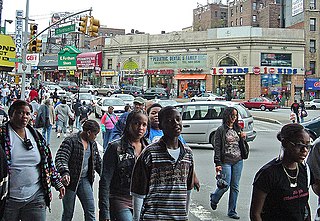
Fordham Road is a major thoroughfare in the Bronx, New York City, that runs west-east from the Harlem River to Bronx Park. Fordham Road houses the borough's largest and most diverse shopping district. It geographically separates the geopolitical North Bronx from the South Bronx.
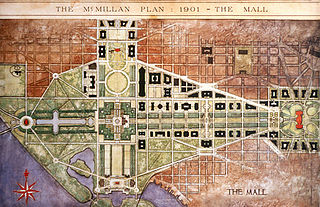
The McMillan Plan is a comprehensive planning document for the development of the monumental core and the park system of Washington, D.C., the capital of the United States. It was written in 1902 by the Senate Park Commission. The commission is popularly known as the McMillan Commission after its chairman, Senator James McMillan of Michigan.
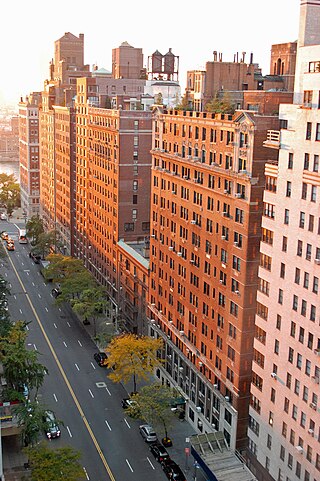
57th Street is a broad thoroughfare in the New York City borough of Manhattan, one of the major two-way, east-west streets in the borough's grid. As with Manhattan's other “crosstown” streets, it is divided into its east and west sections at Fifth Avenue. The street runs from a small park overlooking the East River in the east to the West Side Highway along the Hudson River in the west. 57th Street runs through the Midtown Manhattan neighborhoods of Sutton Place, Billionaire's Row, and Hell's Kitchen from east to west.
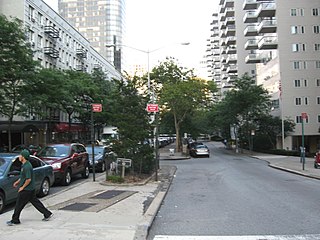
66th Street is a crosstown street in the New York City borough of Manhattan with portions on the Upper East Side and Upper West Side connected across Central Park via the 66th Street transverse. West 66th Street is notable for hosting the Lincoln Center for the Performing Arts between Broadway and Columbus Avenue.

Theodore Roosevelt Memorial Park is a park in the hamlet of Oyster Bay, New York, honoring President Theodore Roosevelt, 26th President of the United States.

The Theodore Roosevelt Monument Assemblage is a collection of 24 stones and plaque located in the Theodore Roosevelt Memorial Park in Oyster Bay, New York. The stones and other objects are meant to each represent a "chapter" and together form a "book" telling the story of Theodore Roosevelt, 26th President of the United States.
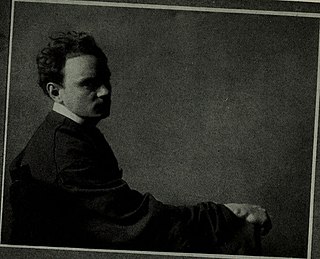
Leo Lentelli was an Italian sculptor who immigrated to the United States. During his 52 years in the United States he created works throughout the country, notably in New York and San Francisco. He also taught sculpture.
Women's rights historic sites in New York City are locales with historical connections to the women's rights movement. In March, 2008, the Government of New York City published an official map of one hundred and twenty historical sites and monuments in the borough of Manhattan.

Equestrian Statue of Theodore Roosevelt is a 1939 bronze sculpture by James Earle Fraser. It was located on public park land at the American Museum of Natural History in New York City. The equestrian statue depicts Theodore Roosevelt on horseback. Walking on either side of him are two men, on one side a Native American and on the other, a sub-Saharan African.

The American Friends Service Committee (AFSC) is a Religious Society of Friends (Quaker)-founded organization working for peace and social justice in the United States and around the world. AFSC was founded in 1917 as a combined effort by American members of the Religious Society of Friends to assist civilian victims of World War I. It continued to engage in relief action in Europe and the Soviet Union after the Armistice of 1918. By the mid-1920s, AFSC focused on improving racial relations, immigration policy, and labor conditions in the U.S., as well as exploring ways to prevent the outbreak of another conflict before and after World War II. As the Cold War developed, the organization began to employ more professionals rather than Quaker volunteers. Over time, it broadened its appeal and began to respond more forcefully to racial injustice, international peacebuilding, migration and refugee issues, women's issues, and the demands of sexual minorities for equal treatment. Currently, the organization's three priorities include work on peacebuilding, a focus on just economies, and humane responses to the global migration crisis.

Vincenzo "Vincent" Miserendino was an Italian-American artist and sculptor born in Sicily and active in New York City during the first half of the 20th century. He studied art first in Palermo at the age of 13 and then in Rome at the Accademia di Belle Arti di Roma. He immigrated to the United States in 1894 at the age of nineteen, and settled on the lower east side of Manhattan, working in many odd jobs while trying to establish himself as an artist.






















